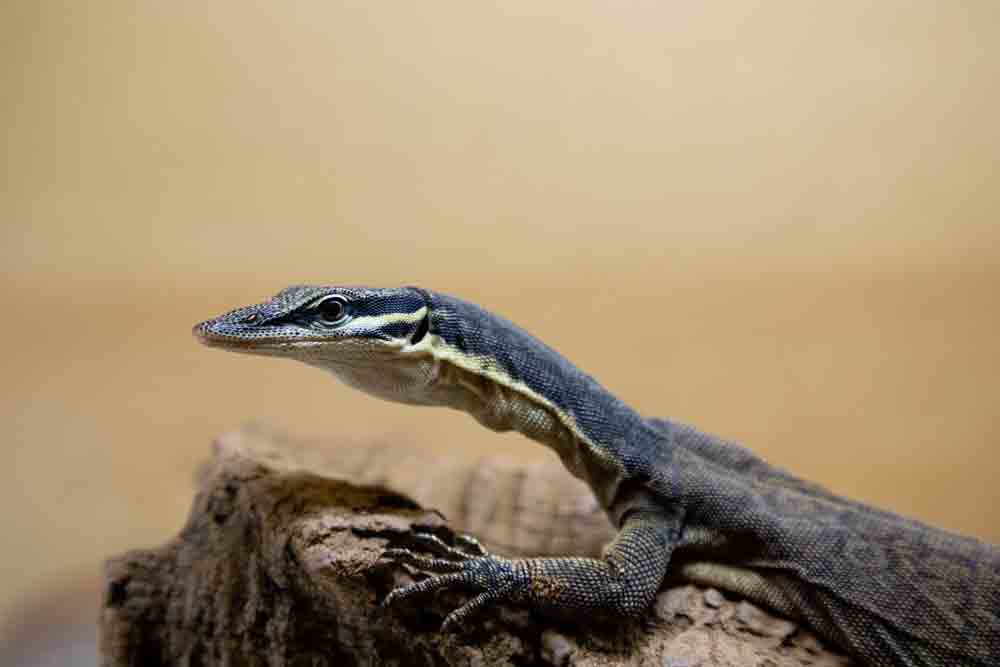If you lack the proper real estate for a water monitor or crocodile monitor, you should absolutely consider a Kimberley rock monitor.
When I moved to Los Angeles from The Bronx in that liminal week between Christmas 2021 and New Year’s 2022, I was beyond excited to begin a new life out West. In the months leading up to the move, I was asked ad nauseum if I moved for a job or to be near family. With a creative and entrepreneurial career directed solely by me and very little family to speak of, surely that 2,500-mile schlep was for a guy I met through the latest privacy-devouring horror Silicon Valley unleashed upon us? None of the above. It was to start over, stop grieving the old New York, and raise giant lizards.
It was my dream ever since I was a little girl to raise big lizards. I’ve always been a frog and toad lady, it’s what I’m actually known for. But I love huge varanids and a crappy apartment in NYC that hasn’t been updated since Truman was in office isn’t exactly a good place to raise one. Not to mention that America’s largest city has some of the most stringent regulations on reptilian pets in the country: literally all monitor lizards are illegal in city limits. Pythons and very large lizards like water monitors aren’t even allowed in the entire state without a special permit, typically reserved for zoos.
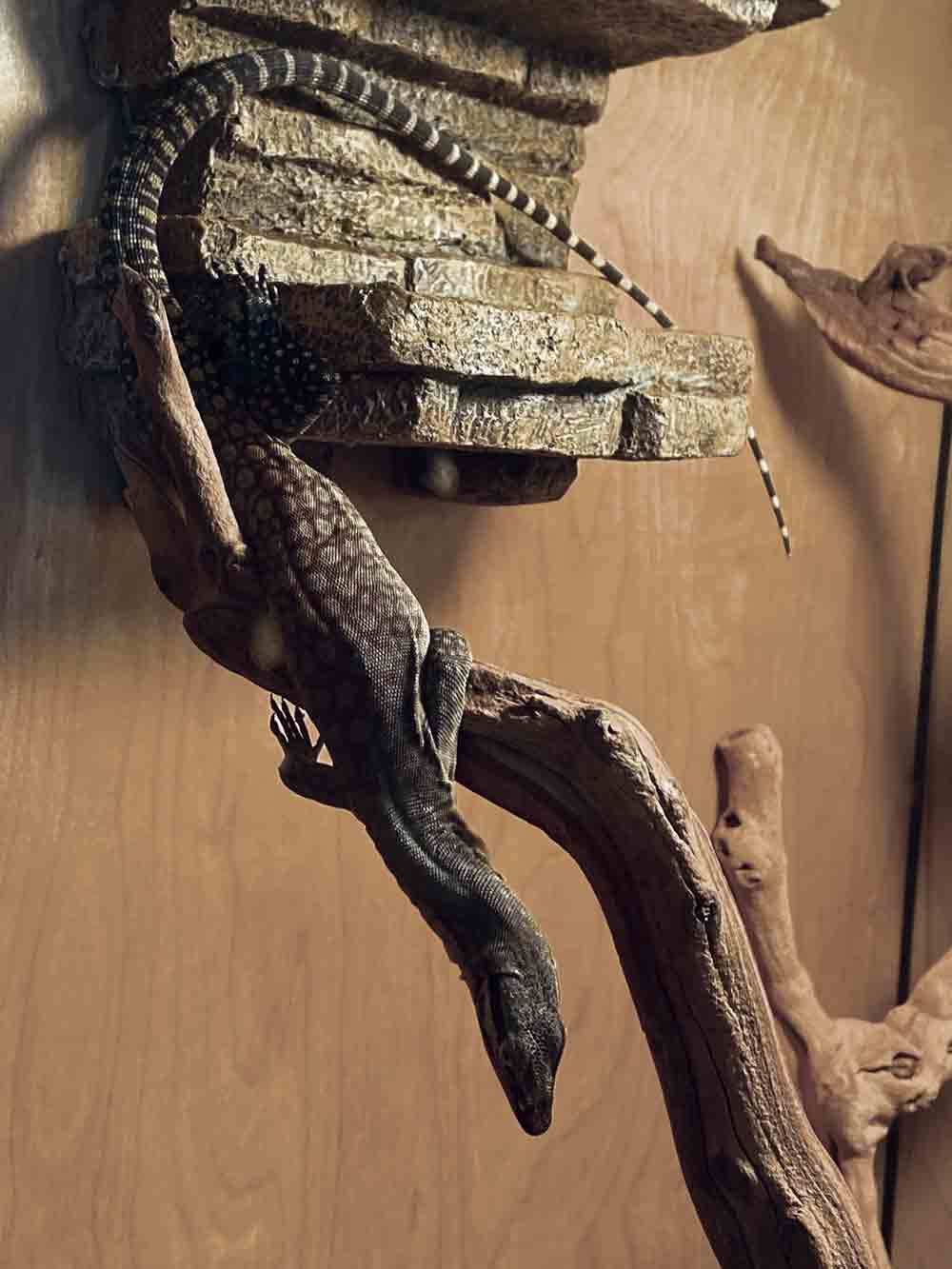
Liora hanging from a branch. Photo by Rachel Presser
Of course, this doesn’t stop people. If your pets are mostly confined to your home and you have good neighborly relations, the law isn’t heavily enforced. You can also jump the border to Westchester or New Jersey to breed reptiles, or just get your reptiles shipped. How else do you think I got my iguana and monitor babysitting experience?
But the lack of local snake and monitor breeding diminished the presence of the reptile hobby in New York. My late toad Yael had the best herpetologist in the Empire State at an exotics-only animal hospital on the Upper West Side. But despite this interesting anomaly, you have to leave the city for a much sparser herpetoculture in a colder, wetter land with smaller and older housing. All of which is not very amenable to starting a scaly family.
But as I settled into LA and gradually built on my new life, I felt this tugging at my heart whenever I watched giant lizard videos. Especially huge, puppy-like Asian water monitors which I still want badly.
King’s Dwarf Monitor Care And Breeding
An Owner’s Guide To The Argus Monitor
I felt utterly baby-crazy for a giant monitor lizard. There’s no other way to describe it. While I’d love to have toads again and lucked out with an exotics-friendly landlord, this irresistible force pulled me toward large varanids. At the Reptile Super Show in Anaheim, I immediately fell in love with a sweet baby water monitor and wanted nothing more than to take him home the second I got to hold him. But with a major surgery imminent and no habitat prepared, I knew it wasn’t time yet.
My apartment is also twice the size of what I owned in The Bronx but definitely not “water monitor spacious.” I didn’t want to commit to a lizard that size if I couldn’t provide the best habitat possible the day I took them home, especially since baby water monitors need an enclosure starting out then you’re talking barely a year before they need that separate bedroom with a pond.
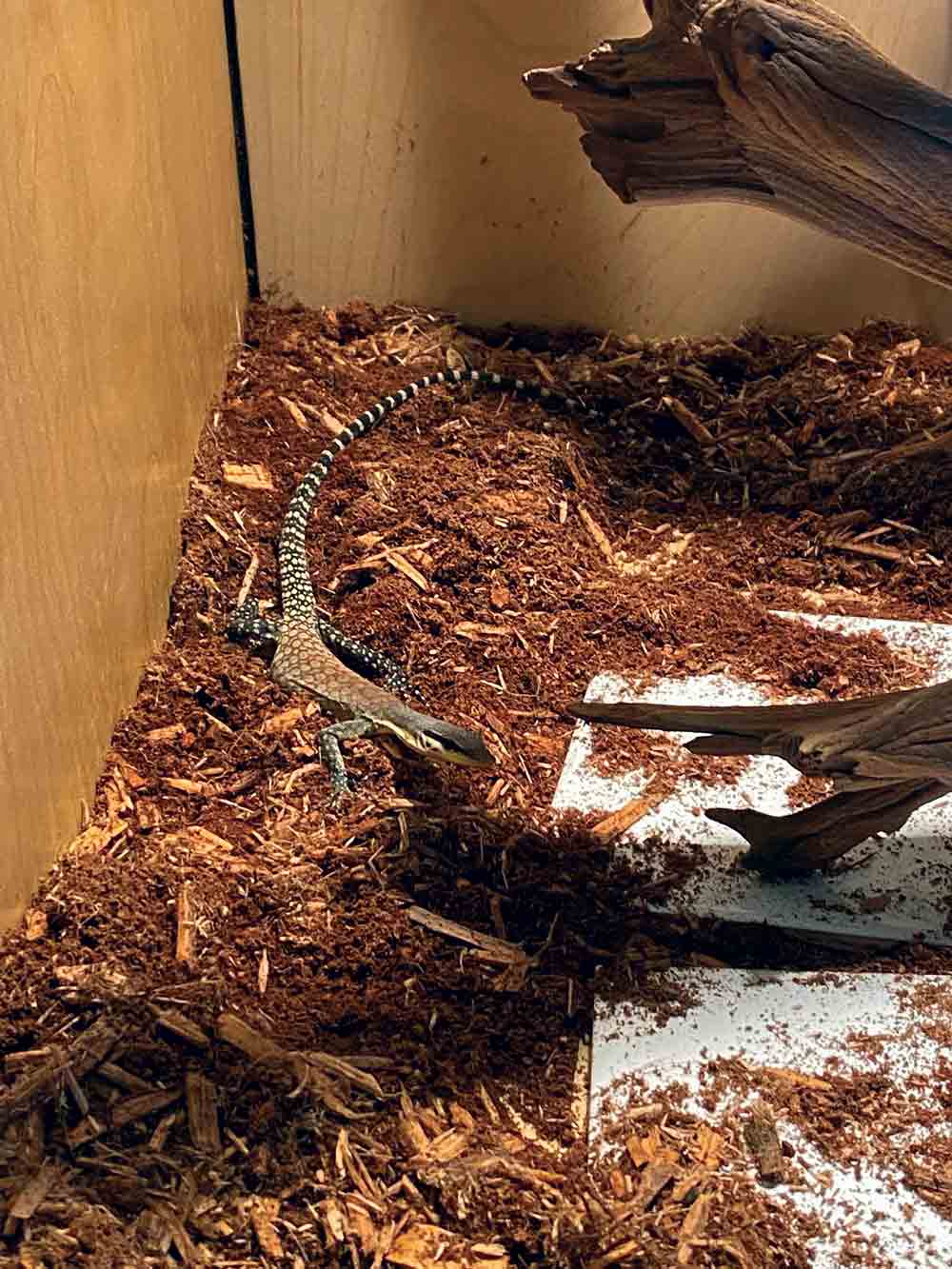
Kimberley rock monitors are small in stature but big on personality. Photo by Rachel presser
That’s when I found out about Kimberley rock monitors. The Anaheim Reptile Super Show was the first time I even heard of these fantastic lizards, much less seen them available for sale when I stopped by the JTK Reptiles booth. The Kimberley rock monitor, Varanus glauerti, is an arboreal desert monitor lizard from Australia. Adults reach about 3-4 feet but most of that length is tail. They are extremely elegant lizards that bear resemblance to perenties (Varanus giganteus) with their seemingly infinite necks connecting lithe bodies to near-flat snouts. But they also have an assortment of stripes and spots with a smudge of black eyeliner just like their water monitor and Argus monitor (Varanus panoptes horni) cousins. Kimberley rock monitors have such a pretty mish-mash of patterns, with reddish diamonds on their backs and spotty legs.
With their compact size and a diet consisting mostly of insects, Kimberley rock monitors require significantly less space and ongoing expenses than large monitor lizards but are larger than Ackie monitors (Varanus acanthurus) with more complex habitat needs. They still need a variety of food, enrichment, and special care taken with their socialization. But if you always wanted a sizable monitor lizard that’s still apartment-friendly, the Kimberley rock monitor is the perfect pet lizard for the space deprived. I definitely knew it was for me. Once I was patched up, I went through the business cards I picked up at the reptile expo and gave JTK Reptiles in Long Beach a ring since they had these amazing lizards.
JTK Reptiles was founded in 2013, though the owner been breeding reptiles for over 15 years. Kimberley rock monitors are slowly making their way across America and I got one of the first captive bred and born generations. JTK Reptiles was one of the first successful Kimberley rock monitor breeders in the LA area, first getting a pair in 2017. My CBB baby was in the 11th clutch produced, putting her a couple generations in but not as far back as other monitor lizard breeding projects.
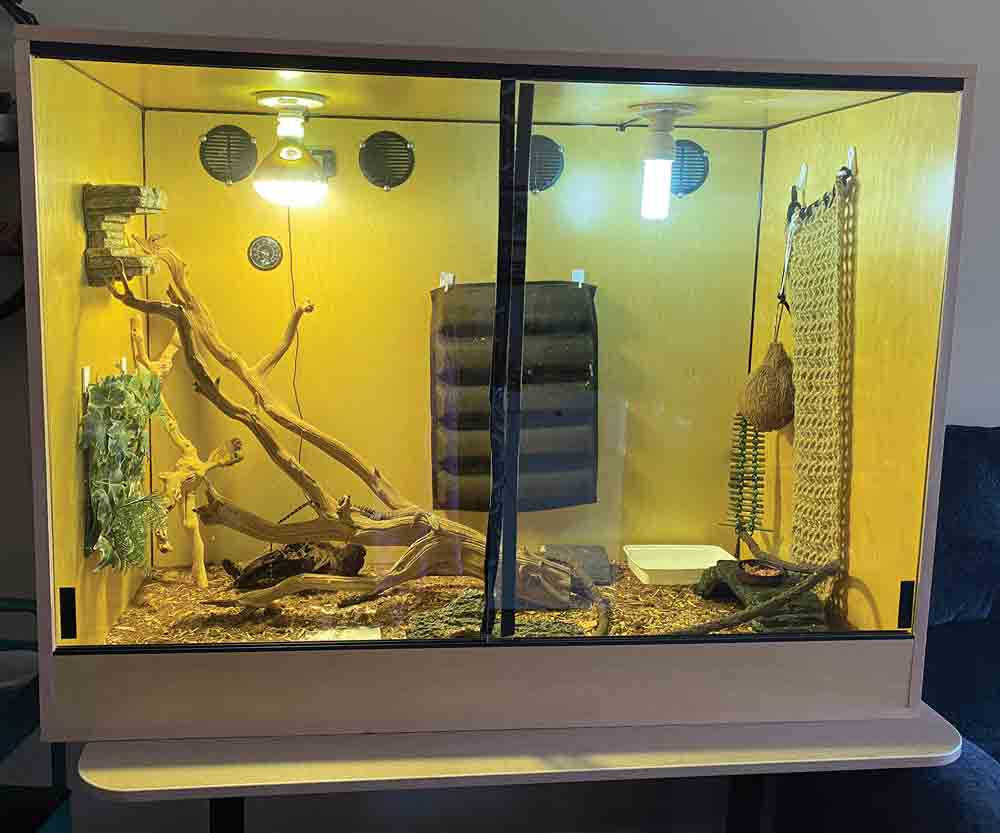
Liora’s enclosure, as set up by her breeder. Photo by Rachel Presser
I thought I was getting a boy at first, then it turns out I got a girl! But I knew I’d love my little dinosaur no matter the sex. So I decided on the name Liora. For non-Jewish readers, we’re a very necronymic people. In my family’s shtetl back in Russia, parents would honor a dead child if they had another by naming them with the same first letter of the decedent’s name. It’s how I got my name, after all. I put a twist on this tradition by using the last letter of my late toad’s name, Yael, to symbolize the circle of life. “Liora” also means “light” in Hebrew: we live in a city of light, one I sought after an extended period of darkness.
Putting Liora’s habitat together, then maintaining it, was fairly simple. Acquiring it was a little harder. Florida may be the seat of America’s reptile trade, but the hobby’s presence is almost ubiquitous in Southern California. I was used to seeing the few legal species classifieds sitting for weeks back east. Out here, someone right behind you will get that baby monitor you’re eyeing if you’re not fast enough. Despite this, there’s one thing that remains constant no matter where you are: if you need a custom habitat and lack sufficient carpentry skills to build it yourself, at least two companies will flake on you before you get someone who will order or build it. As luck had it, JTK Reptiles was more than happy to get the habitat ordered for my incoming baby after I inquired about the latest Kimberley clutch.
Even better, the owner personally came to my apartment to get the habitat set up correctly and review the supplies I already bought from various retailers. While I’ve babysat lizards of varying size in the past, this is my first time having my own monitor so I really appreciated the extra care that was given to welcoming this baby home! A fellow Bronx expat, he totally understood how long I waited for this dream to come true. Setting up a monitor enclosure, especially a tall one for a monitor that will grow, was definitely more difficult and expensive compared to the toad habitat I had.
For the base, I used a Bekant standing desk from IKEA. It can hold up to 150 pounds and the legs are adjustable. It doesn’t have a fancy motor so you need to carefully decide on the height as you don’t want to change it before the terrarium pops on. I used the factory preset because I’m very short and need to reach high points easily. Taller users who don’t want to tower over their lizards should adjust the legs higher.
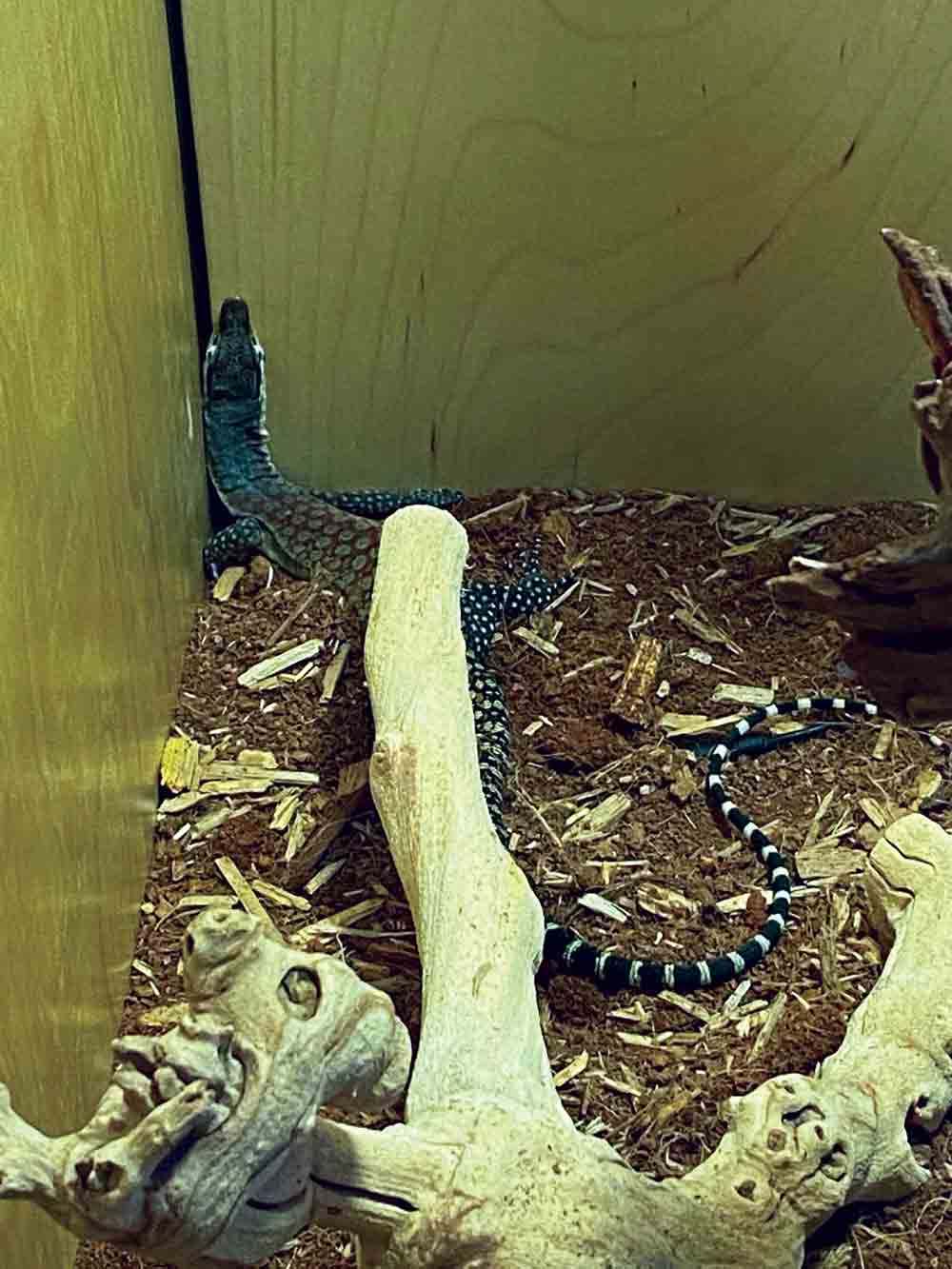
Frances are provided for Liora to climb. Photo by Rachel Presser.
I arranged for a 48” wide wooden terrarium that’s 24” thick and 36” high. Wooden terrariums are better than glass when it comes to desert monitors because they hold heat more efficiently. Since this enclosure has sliding glass doors, I got some Velcro tape and put the soft sides down the middle where the doors meet. This is because Kimberley rock monitors can take advantage of their narrow snouts and bodies, flattening themselves into monitor pancakes that can easily escape.
Liora will tap on that glass when she wants my attention and to explore, though she’s still not that keen on being picked up. She’s too fast and small to come out on her own to bask in the sunny spot by my desk, but I promised her she can when she’s bigger and more amenable to handling.
Kimberley rock monitors love to climb, they’re arboreal lizards. I put in a large branch, a small one, various log hides, and gradually added climbable wall decorations when I saw that Liora kept trying to climb the walls.
I got a handmade rope reptile hammock from Etsy that I hung upright so Liora could climb on it, then later added a coconut hide with a bridge attached to her bendy branch. As luck had it, I ordered a silicone bread pan that wound up not meeting my expectations as I didn’t feel comfortable putting mesh in the oven or dishwasher. I cut two holes in it and made it into her new enrichment toy, figuring the material could at least withstand the heat and was probably no worse than what Repti-Rocks are made of.
For heat and lighting, I started with a 75W heat lamp bulb on the left fixture then upgraded to a 160W PowerSun. It’s radiating from a higher point than most melamine cages, so she really needed that extra wattage. Liora’s happy with a 7.5 UVB bulb on the right fixture, but I plan on upgrading to 10.0 when I have to change the bulb in six months. I also put some basic small ceramic tiles in the basking area, though she usually basks on the highest point of her branch.
Using a spot-check thermometer, I found that she has a nice gradient running from 85 degrees Fahrenheit (29.4 degrees Celsius) on the cool and low side to 110 degrees Fahrenheit (43.3 degrees Celsius) in her favorite basking areas closer to the heat lamp. Some care sheets say that Kimberley rock monitors like temperatures up to 130 degrees Fahrenheit, but Liora starts mouth-breathing on really hot days so I don’t go any hotter.
The custom enclosure I ordered through JTK has nifty built-in fixtures so there’s no need for clamp lamps. For ultimate ease in managing Liora’s lighting needs, I got a set of Kasa smart plugs that I can control with my phone. They’re a breeze to set up and you can even tune them to turn on and off with the sun, allowing your reptiles a more naturalistic lighting option. But out of consistency, we operate 12 hours on and 12 off. The only drawback with Kasa is that if I’m not home, I can’t tell if they’re on or off because I’m out of range. Once in a while, the UVB fixture won’t respond to the timer and I need to tap it in the app or manually flick the switch.
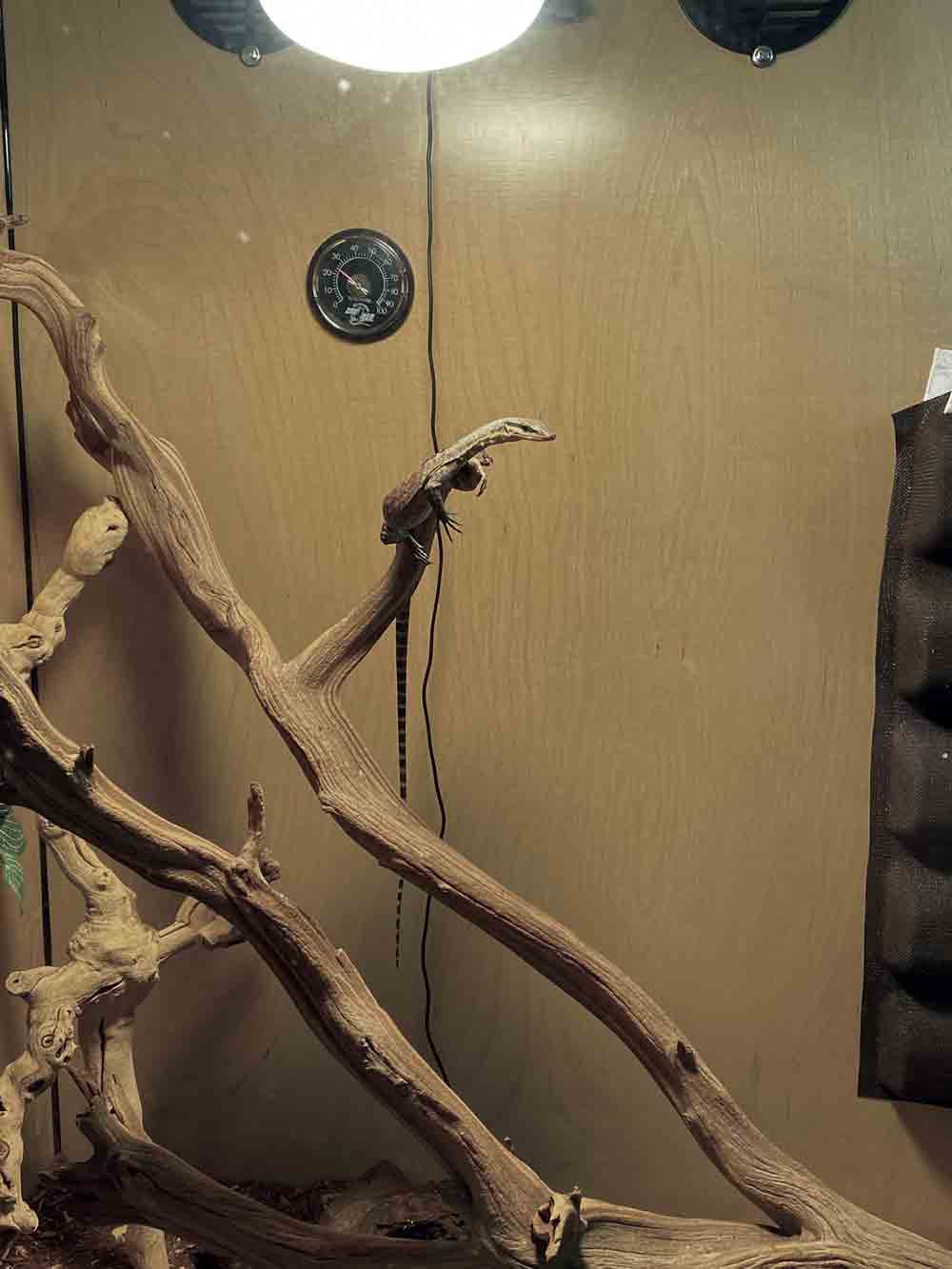
With proper care, Kimberley rock monitors can live more than 20 years. Liora enjoying some light.
As for food, Liora can be picky. With me, she doesn’t eat many of the things the breeder fed her. As a vegetarian, I really hate handling chicken gizzards but I do it because I love my baby. But even when I cut them small enough, she barely touches them! She loves hard-boiled egg, though. I need to dice it super-fine like one would for a toddler, yet she will chase and take back a massive roach wider than her body like a mini Komodo dragon. Then I found the San Diego Zoo’s recipe for Komodo dragon chow, and it’s a winner. You mix a pound of ground turkey with two eggs, shells included, and a tablespoon of Repti-Cal. This little dragon loves it. She went back for thirds!
Liora only eats live bugs that hop or crawl, like dubias and grasshoppers. Very unimpressed with worms, she didn’t want to eat any type I introduced to her habitat. She’s not into fish at all and I sprang for quality sashimi from H-Mart, no less. I even got her a whole shrimp and she turned her snoot up.
Fortunately, she loves poultry. The independent butchers at the Fairfax Market sell ground versions you can’t find at the supermarket and are happy to honor requests for picky lizard toddlers.
Since she’s growing so fast, she sheds a lot and it’s normal for Kimberley rock monitors to not want to eat or do much else during a big shed. Keep a close eye but baby monitors are normally ravenous when they aren’t shedding.
Kimberley rock monitors may be smaller than their more well-known Varanid cousins, but they pack just as much personality. With most of my stewardship experience being with monitors that love to swim, and my husbandry experience primarily in amphibians, it’s been a trip caring for a desert monitor lizard that is incredibly hydrophobic. If just a droplet of water makes it onto my baby’s tail, she will zip to the other side of the enclosure or hide somewhere.
Given Australia’s climate, this shouldn’t come as a shock. Whereas one of the greatest things about reptile husbandry is that it shows us how much we don’t know.
I’d read that Kimberley rock monitors have potential to develop wonderful personalities. Liora is still quite skittish two months in, she won’t tong-feed yet and doesn’t crawl onto me. But just as she’s physically grown so much in just two months, socialization with her has required patience and celebrating the progress made. Liora loves to play, climb, investigate, and hang upside down. Hanging in strange positions is one of her favorite pastimes. She is a glamorous Hollywood girl, a ferocious apex predator, and an absolute goofball all at once.
Talking to your lizard is an underestimated element of socialization, so even when she doesn’t want to be handled I talk to her frequently. She curiously cocks her head, and sometimes looks right at me as if she can understand me. Monitor lizards are so smart. SO freaking smart. You may be aware of this if you’ve kept them, but you really don’t know the extent of it sometimes. Liora paws on the glass when she wants my attention. One night, she relentlessly clanged on the glass while I tried to work. I got up to talk to her, frustrated that every time I opened the door she wouldn’t interact but would be back at that glass the second I sat down. She repeatedly pointed her paw to the right side of the enclosure. Then I realized her rope wall looked saggy, and it hit me: the hook holding up her rope wall and coconut had fallen, and she wanted me to fix it!
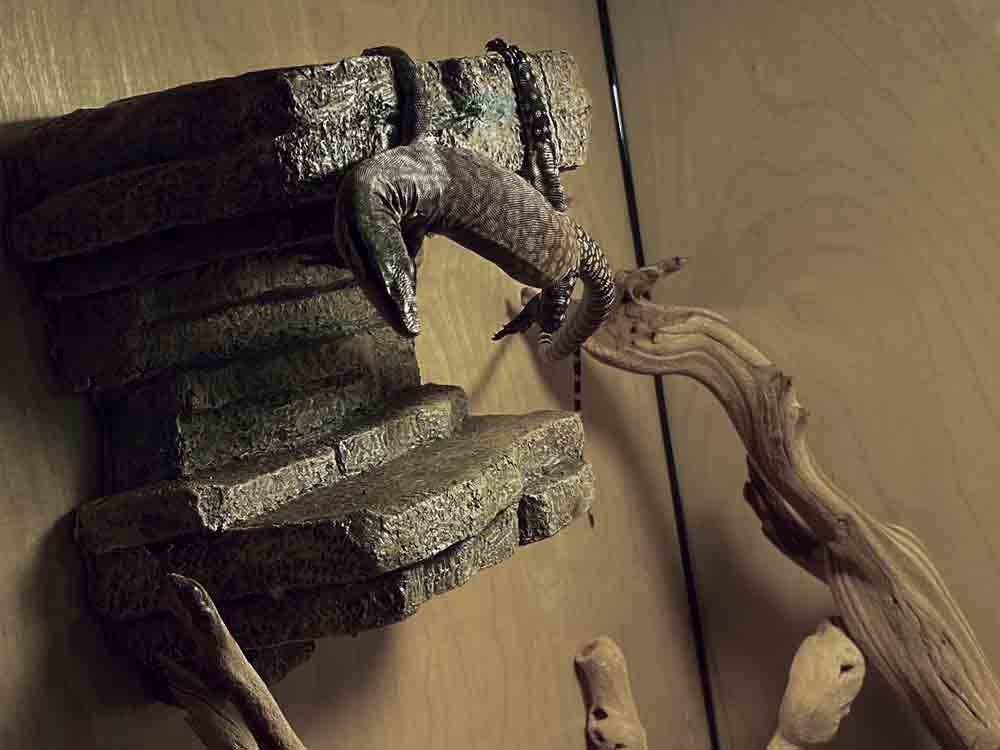
Moving from climbing spot to climbing spot. Photo by Rachel Presser
Your lizard will come to associate you with food and love. Some days, Liora still yeets to the other side if I get too close. But I’ve been putting my hand in and letting her just get used to me. If I get too close to pet her or pick her up, she’ll scramble to the other side. There’s times I wasn’t sure if our socialization efforts were working or not. But I’m at the point where I can put my hand near her perch or just rest near the glass doors and she’ll curiously give me monitor kisses. Which is a good sign!
I also had to change her substrate because it was getting really gross, which entailed putting her in the travel tank so I could vacuum and scoop. I figured I’d use it as an opportunity to get her used to handling: she not only did curious tongue flicks every time I petted her, I let her climb on me to explore and she rested her head on my boob like a human baby, contentedly sleeping there for a little bit.
Liora will want my attention one day then hide from me the next. She has moods just like people do. She also bobs her head sometimes: to Agnostic Front and Kal-El, the signoff music on YouTube cooking videos, and just plain the beat of the world. With a life expectancy of about 20 years with excellent care, I look forward to the incredible apartment dinosaur Liora will certainly become. And if you’re dying to have a smart monitor lizard you can train and talk to, but lack the proper real estate for a water monitor or crocodile monitor, you should absolutely consider a Kimberley rock monitor. Raising a giant lizard from a baby was a lifelong dream of mine that I’m now living, and it’s even more fulfilling than I imagined it would be!
Rachel Presser is a writer and game developer from The Bronx, and the founder of Sonic Toad Consulting. She has been keeping frogs and toads for 25 years which earned her the title of “that toad lady” in the games industry, and now resides in Los Angeles with her baby Kimberley rock monitor, Liora. Rachel’s Instagram full of Liora pictures and her various endeavors can be found at linktr.ee/sonictoad

